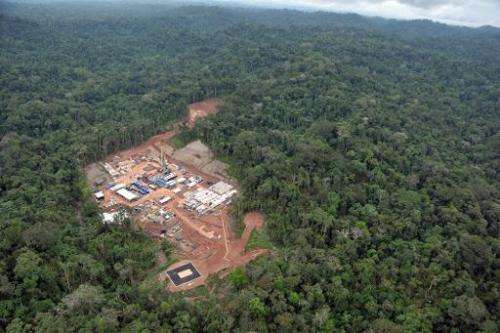Illegal logging widespread in Peru, says study

A 14-year-old policy to encourage sustainable logging in Peru's Amazonian forest has unwittingly led to large-scale plundering, a study said Thursday.
In a paper published in Scientific Reports, researchers said illegal logging was a "plague" on the Amazon watershed—a haven of biodiversity and precious hardwood species such as mahogany and cedar.
"Much of the timber coming out of the Peruvian Amazon is sourced outside of authorised concession areas," the researchers wrote.
A team led by Matt Finer of the Center for International Environmental Law in Washington trawled through data kept by agencies meant to enforce Peru's 2000 Forest and Wildlife Law.
The legislation empowers the government to award concessions for up to 40 years on public land between 4,000 and 50,000 hectares (10,000 and 125,000 acres).
These contracts come hedged with conditions: loggers must submit a five-year harvesting strategy, including a highly detailed, year-by-year plan that identifies each individual tree to be cut, with Global Positioning System (GPS) coordinates.
Finer's team found that by September 2013, the authorities had scrutinised 388 of the 609 logging concessions.
More than 68 percent of the 388 were found either to have committed "major violations", or were suspected of it.
In 181 cases, the license was revoked. More than half of the recorded violations were for taking timber from a non-concession area or for unauthorised cutting of cedar and mahogany.
Additional work by non-government monitors and satellite images supported these findings, the paper said.
It faulted the system for placing too much trust in documents and for carrying out checks at ports rather than on-site, which thus enabled trees taken illegally to be easily laundered.
The investigation touches at the heart of difficulties to protect remote carbon-capturing tropical forests, which is one of the goals of UN efforts to combat climate change.
Some observers say the answer lies in putting forests under the control of local people, who have a more credible record of protecting the resource.
Alberto Pizango, head of the AIDESEP campaign group gathering dozens of indigenous communities in the Peruvian Amazon, said the investigation backed widespread anecdotal evidence.
"This new study supports the stories we are hearing from communities across the Amazon," Pizango said in a statement.
"The findings also reinforce our demand that the government help us to protect our lands, and that it recognise our rights over the forests where our peoples have lived for hundreds of years."
Pizango and other leaders have been accused of inciting clashes between police and native people in the Amazonian town of Bagua in 2009 that left 34 dead.
Journal information: Scientific Reports
© 2014 AFP


















